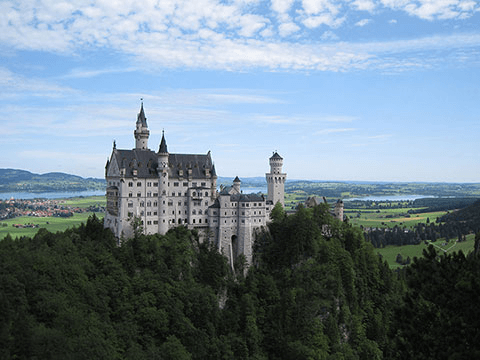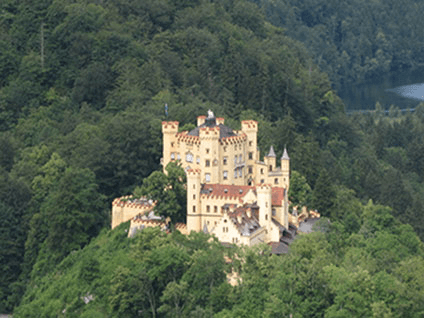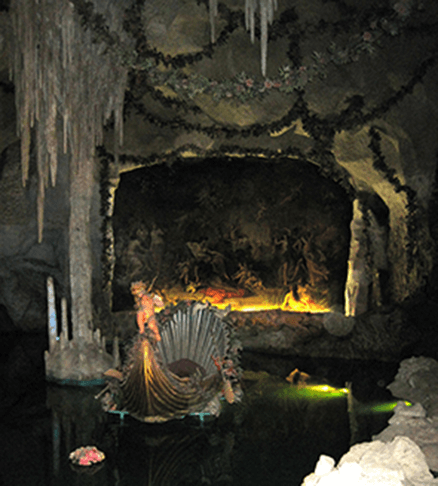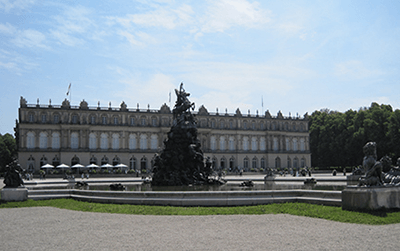In Search of Crazy Ludwig
by Joey Green
In the 1800s, he built castles so enticing that Walt Disney eventually used them as inspirations for his fairy tales. But was the young king inventive—or insane?

It's a mission that does not seem to be resonating with our daughters. Or as Ashley, our 19-year-old, asks: "Couldn't we just go to Disney World instead?"
From the Munich airport we drive southwest for two hours through the lush, Bavarian countryside, where men still dress in lederhosen, women wear dirndls, and everyone seems to wash down bratwurst and sauerkraut with a one-liter stein of lager. Traveling on a budget, we room in villages off the beaten path, in clean, comfortable, family-style guesthouses where traditional Bavarian breakfast consists of cheese slices, soft pretzels, thin slices of ham, white sausages and a jar of Nutella.
"Ashley was right," says Julia, 14, our younger daughter and a notoriously fussy eater. "We should have gone to Disney World."

When Ludwig's father died in 1864, 18-year-old Ludwig became king of Bavaria and did what any 18-year-old monarch obsessed with Lohengrin would do: He summoned for his idol, Richard Wagner. Ludwig paid off the composer's countless debts and became his patron, financing the lavish premieres of Wagner's operas. "Beloved one, Holy one!" Ludwig wrote in a letter. "I am like a spark longing to be inflamed and illuminated in the rays of your sun."
Like a die-hard fan, young King Ludwig commissioned a theatrical set designer to create architectural plans to build a magnificent, idealized medieval knight's castle to pay homage to Wagner's operas Lohengrin and Tannhauser. Spending his personal fortune and not public money, Ludwig built a series of elaborate palaces to create a fairy-tale fantasy world that he could rule as a reclusive king, enjoying operas and plays privately staged for an audience of one.
"Wait a second," says Ashley, as we walk uphill toward Ludwig's new castle (now called Neuschwanstein, meaning "new swan stone"). "Isn't that the castle in Chitty Chitty Bang Bang?"
"Yes," says Debbie, "and Around the World In 80 Days."
"There better be a ride inside," says Julia.
Inside Neuschwanstein, paintings, murals, tapestries and mosaics depict romanticized scenes from the legend of Lohengrin. Huge chandeliers lit by more than 600 candles hang in the massive Hall of Singers. In the majestic throne room, inspired by the St. Sophia Basilica in Istanbul, Julia takes a look around, summons her inner Beauty and the Beast and says, "Where's Belle, Lumiere and Mrs. Potts?"
For our girls, the crowning jewel of Ludwig's New Castle is the stunning view from the Marienbruke suspension bridge that spans Pollat Gorge, only a 15-minute walk uphill in Ludwig's backyard. From there, we walk down the gorge trail, admiring the 148-foot-tall Pollat waterfall.
"This is like a real, live fantasyland," says Ashley.
From Neuschwanstein, we drive winding roads an hour east to Linderhof Palace, Ludwig's royal villa, which has a baroque facade that makes it seem puny in the wake of Neuschwanstein. Our girls can't believe the nocturnal king spent most of his nights in the Hall of Mirrors, which, when illuminated with candles, reflects the light incalculable times, creating the illusion of an endless corridor. A 108-candle crystal chandelier hangs in the bedchamber, and the table in the dining room sits on a platform that could be lowered into the kitchen on the floor below, so that Ludwig, who had become self-conscious of his bad teeth, could dine alone without ever seeing the servants. Upon the hill beyond the lavish, terraced gardens is a Moorish kiosk furnished with a bizarre peacock throne, where Ludwig sat smoking a hookah amid servants garbed in Berber costumes.

Now the girls confess their curiosity to explore the true objective of our journey—the facsimile of Versailles on Herreninsel, a 593-acre island in the middle of a large freshwater lake affectionately called the Bavarian Sea. From the town of Prien am Chiemsee, we take a boat to the island and then stroll along a path through the woods to Herrenchiemsee Palace, which, sure enough, looks like a carbon copy of Versailles. Built as a monument to Louis XIV of France, whom Ludwig zealously admired, Herrenchiemsee boasts a Hall of Mirrors larger than the Hall of Mirrors in Versailles and containing 77 chandeliers. Ludwig designed his dressing chamber with floor-to-ceiling mirrors and gilded carvings of trees to make the room look like a boundless fairy-tale forest where Peter Pan and Tinker Bell might gallivant.

"He was definitely crazy and committed suicide," declares Ashley.
"No," protests Julia. "He was a genius who got murdered."
"If Ludwig were alive today," says Debbie, "he'd be a Disney Imagineer."
Who's right? You be the judge. All I know is that our girls had an experience far more mind-blowing than Snow White's Scary Adventures.
You Might Also Enjoy Reading:
Copyright Ⓒ 2014 by Joey Green. All rights reserved. Reprinted from American Way magazine.